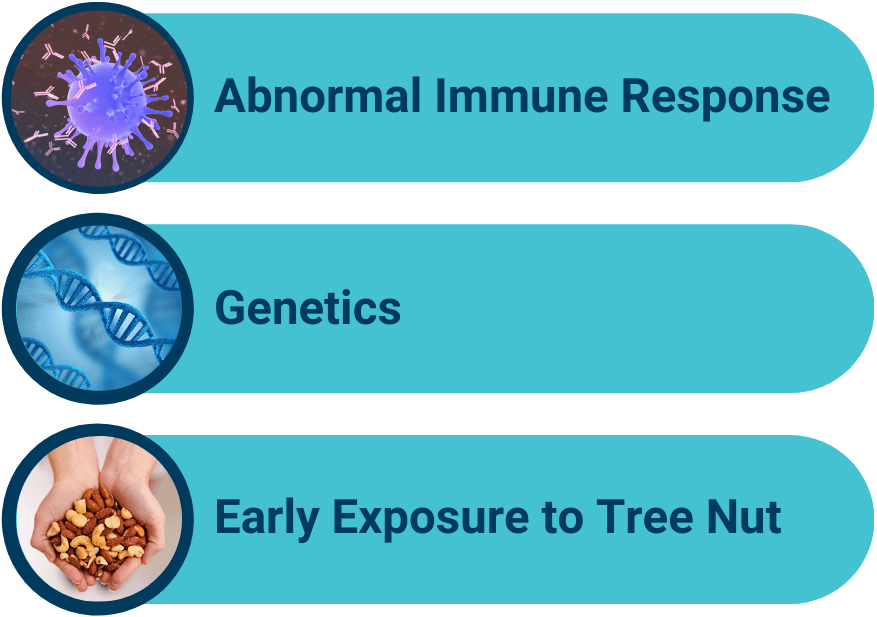Tree Nut Allergy Symptoms and Treatment
TIP is an effective solution for tree nut allergies in children and young adults. Find out if TIP is right for you with the our quiz.

A tree nut allergy is an allergic response to the proteins present in tree nuts, including, but not limited to, hazelnuts, cashews, almonds, walnuts, pecans, and pistachios. According to studies published in 2018 and 2019, 3.9 million Americans were allergic to tree nuts.
Research demonstrates that over 2% of children are affected by tree nut allergies, and many will carry these allergies into adulthood. Close to 50% of children that are allergic to one tree nut will also have allergic reactions to another tree nut.
Because tree nut allergy reactions can be severe and, in some cases, life-threatening, it is important to diagnose and treat a suspected tree nut allergy as soon as possible. The following sections provide an overview of common tree nut allergy reactions, tree nut allergy causes, and tree nut allergy treatment.
Tree Nut Allergy Symptoms
Tree nut allergies can trigger a range of symptoms, which can vary in severity from person to person. Reactions may result in a variety of skin, respiratory, digestive, and cardiovascular manifestations. These manifestations may include:
- Hives or skin rash
- Mouth or throat becoming itchy
- Difficulty swallowing
- Runny nose
- Itchy eyes
- Abdominal pain or cramps
- Diarrhea
- Nausea or vomiting
- Wheezing, coughing, shortness of breath

Severe tree nut allergies are among the most common allergies that lead to anaphylaxis (anaphylactic shock). Anaphylaxis is a severe allergic reaction that can be life-threatening. Symptoms of an anaphylaxis include
- Shortness of breath (and/or wheezing)
- Constriction of the throat
- Persistent dizziness or collapse
- Confusion
- Weak, rapid pulse
- Pale and floppy (young children)
Tree Nut Allergy Causes
Tree nut allergies are primarily caused by an abnormal immune response to proteins found in tree nuts. When an individual with a predisposition to tree nut allergies comes into contact with tree nut proteins, their immune system mistakenly identifies these proteins as harmful invaders and triggers a tree nut allergy reaction.
A family history of tree nut allergies can increase the risk of an individual developing a tree nut allergy.

Additionally, early exposure to tree nuts during infancy may influence the development of allergies. Although the exact mechanisms are still under investigation, these insights into the causes of tree nut allergies are vital for both prevention and peanut allergy treatment.
Tree Nut Allergy Testing
Tree nut allergy testing plays an important role in diagnosing and managing allergies to tree nuts, which can be life-threatening for some individuals.
Tree nut allergy testing may include:
Skin Prick Test
A test in which the skin is lightly pricked with a tiny amount of tree nut allergens, followed by monitoring for a reaction.
Blood Test
Measures the levels of IgE antibodies developed by the immune system, providing valuable information about the severity of the allergy.
Component Test
A blood test that evaluates a patient’s ability to tolerate specific components of allergens. A tree nut allergy component test is essential in differentiating between a cross reaction to pollen or a potentially life-threatening allergic reaction.
Oral Food Challenge
A gradual process in which a patient consumes a small amount of a suspected allergen over a period of three to four hours. As serious allergic reactions can be life-threatening, it should only be conducted under the guidance of a qualified clinician.
FAI’s Advanced Food Allergy Testing
Our Foundation Labs (CLIA Certified) specializes in component testing of 130+ different allergens, including allergen components that are not available at national laboratories and hundreds of different biomarkers.
Foods to Avoid to Prevent
Tree Nut Allergy Reactions
An individual who has a tree nut allergy is likely to be allergic to other tree nuts as well. A doctor may suggest that you avoid all nuts, as well as avoiding peanuts, as they are more likely to come into contact with tree nuts during production and processing. If you have a tree nut allergy it is important to avoid any foods containing tree nuts and any of the following
- Almond
- Artificial nuts
- Beechnut
- Black walnut hull extract (flavoring)
- Brazil nut
- Butternut (also known as white walnuts; not squash)
- Cashew
- Chestnut
- Chinquapin nut
- Coconut
- Filbert/hazelnut
- Gianduja (a chocolate-nut mixture)
- Ginko nut
- Hickory nut
- Litchi/lichee/lychee nut
- Macadamia nut
- Marzipan/almond paste
- Nangai nut
- Natural nut extract (e.g., almond, walnut-although artificial extracts are generally safe)
- Nut butters (e.g., cashew butter)
- Nut distillates/alcoholic extracts
- Nut meal
- Nut meat
- Nut milk (e.g., almond milk, cashew milk)
- Nut oils (e.g., walnut oil, almond oil)
- Nut paste (e.g., almond paste)
- Nut pieces
- Pecan
- Pesto
- Pili nut
- Pine nut (also referred to as Indian, pignoli, pigñolia, pignon, piñon and pinyon nut)
- Pistachio
- Praline
- Shea nut
- Walnut
Prepared Foods that Commonly Contain Tree Nuts
Tree nuts are not always present in these foods, but it is important to read food labels and ask questions about ingredients before consuming something that you have not prepared yourself.
- cereals
- crackers
- cookies
- candy
- chocolates
- energy bars
- flavored coffee
- frozen desserts
- marinades
- barbeque sauces
- cold cuts, such as mortadella
Tree Nuts May be Found in Unexpected Places
- Chinese, African, Indian, Thai and Vietnamese restaurants pose a high-risk for people with tree nut allergies. Even if you order a dish with out tree nuts, there is a high risk of cross-contamination.
- Tree nut oils, such as walnut and almond, may be used in lotions, hair products and soaps.
- Crushed walnut shells are sometimes used in "natural" sponges or brushes due to their durability.
- Some tree nuts are used as ingredients for DuraFlame logs.
- Both of these conditions can lead to diarrhea, nausea and vomiting. Lactose intolerance is a not life-threatening condition, but a casein allergy may be. If you think you or your child has either of these conditions, it's important to consult a doctor.
Other Names For Tree Nuts
- Anacardium nuts
- Mandelonas (a nut-flavoured peanut confection)
- Nut meats
- Queensland nut (macadamia)
Tree Nut Allergy Causes
Tree Nuts are not the same as peanuts. Peanuts grow underground and are part of a different plant family known as legumes. Other examples of legumes include beans, peas, lentils and soybeans.
While approximately 40% of children with tree nut allergies also have peanut allergies, those with a tree nut allergy may not necessarily have a peanut allergy. Testing for both tree nut allergies and peanut allergies is important for safety.
Tree Nut Allergy Treatment
For those with severe tree nut allergies, the only proven food allergy treatment that makes it possible to achieve remission is the Food Allergy Institute's Tolerance Induction Program™ (TIP).
TIP™ builds tolerance to the unique proteins each individual is allergic to, all before introducing their most anaphylactic allergen(s).
This ensures patient safety, and over time alters their immune system to not react to any of their allergens. Once an individual has reached remission, they can eat like anyone without a food allergy for the rest of their life.
OIT and similar food allergy treatments aim to desensitize patients to protect them from "accidental exposure." Through TIP™, patients can eat as freely as a non-allergic person would.
Allergens Treated
The Tolerance Induction Program™ (TIP) successfully treats ALL severe food allergies, including the TOP 9 major allergens and many more!
- Peanuts
- Tree Nuts
- Milk
- Eggs
- Shellfish
- Wheat
- Soy
- Fish
- Lentil
- Mustard
- Sesame
- And more
Insurance Carriers
We accept most PPOs* from the following carriers:
